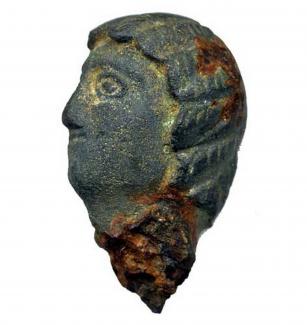Fragment of a Roman cast copper-alloy and iron possible furniture fitting in the form of a female head, perhaps Julia Domna. The hairstyle is very well defined with a waved, coiffed fringe with six sections either side of the centre, a centre parting on the back of the head leading to a bun which is made up of three elements on each side. The hair is defined with curving stamps. The nose is triangular and the large oval-shaped eyes have a broad outline and a raised central oval moulding to represent the eye-ball. The mouth is disproportionally small and is made up of two narrow parallel mouldings which lack further definition. The iron core is visible at the neck. Iron corrosion on the head. Dates to about AD150-AD250. Found by metal detector at Droxford, Hampshire.
Furniture fitting in the form of a female head
Roman, about 150AD-250AD
Found with a metal detector at Droxford, Hampshire in 2001
A fragment of a cast copper-alloy furniture fitting with an iron core, in the form of a female head. The hairstyle is elaborate, with a waived, coiffed fringe, and a centre parting on the back of the head leading to a bun. It has been suggested that the head is that of Empress Julia Domna, the wife of Emperor Septimius Severus. She was a powerful figure in the late 2nd and early 3rd centuries AD, helping to rule the Empire along with her husband and later with her two sons Caracalla and Geta.
Portable Antiquities Scheme find number HAMP1700.



